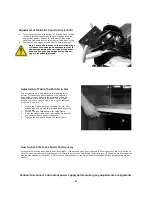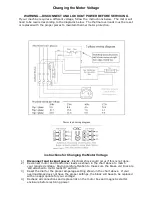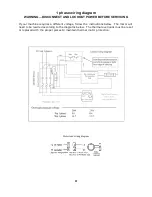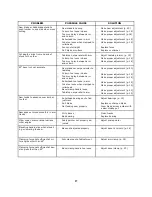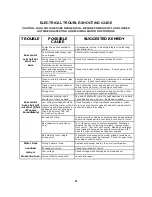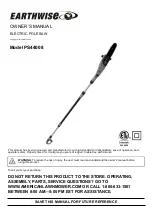
28
28
TROUBLE
POSSIBLE
CAUSE
SUGGESTED REMEDY
Power line not connected to
cable.
Correct power wiring. See wiring diagram inside mag-
netic starter box.
Saw motor
Thermal overload relays may
have tripped.
Allow time for overload relays to cool.
will neither
start nor
Faulty (brown) line fuse, line
circuit breaker tripped.
Check for presence of proper voltage at motor.
hum
Defective control transformer.
Start and stop switches at end
of arm may be defective.
Check circuit with continuity meter. Ensure power is off.
Faulty starter.
Open circuit in a thermal relay
heater.
Remove heaters. If defective, heater may be completely
burned up. Install new heater if required.
Open circuit in motor cable or
cable lugs.
Use a continuity meter and check each wire between
control unit and motor. Check lug connections.
Wiring error.
Check connections in starter box and conduit box, refer
to motor and starter connection diagrams.
Mechanical binding—shaft
should turn freely by hand.
Tap end of shaft with mallet to seat bearings in end bells.
Check bearings and bell etc. Replace as needed.
Saw motor
hums but will
not start (Shut
off power
immediately)
Low voltage
-
voltage should be
measured at the motor while it
is starting and blade attached.
Voltage should not drop lower
than 185 volts for 208, 220
and 230 volt systems.
Check for loose or high resistance connections–
make
sure lines are of ample capacity and other equipment is
not pulling down the voltage.
Burned out stator
If motor smells or has been smoking each phase winding
should be checked with a test lamp or continuity meter.
Bad capacitor (single phase
only).
Turn off power, remove motor nameplate. Discharge
capacitor by short circuiting terminals; remove motor
from circuit. Test with ohm meter. Needle should jump
when leads are touched to capacitor terminals and fall
back to a high resistance as capacitor charges.
Bad starting relay (single
phase only).
If contacts are excessively burned, pitted or welded to-
gether the relay must be replaced. Check for open relay
coil using continuity meter.
Motor trips
Wrong heater or fuse.
Replace with proper heater, fuse or circuit breaker.
overload
Excessive currents.
Check for grounds or shorts.
relay or
Low voltage.
Check voltage while starting as outlined above.
blows line fuse.
Loose or faulty connection.
Locate and repair.
ELECTRICAL TROUBLE-SHOOTING GUIDE
CAUTION
—
HIGH VOLTAGES ARE DANGEROUS
—
BE SURE POWER IS OFF AND LOCKED
OUT WHEN INSPECTING OR REPAIRING MOTOR OR CONTROLS
Содержание 3531-01
Страница 11: ...11 11...








